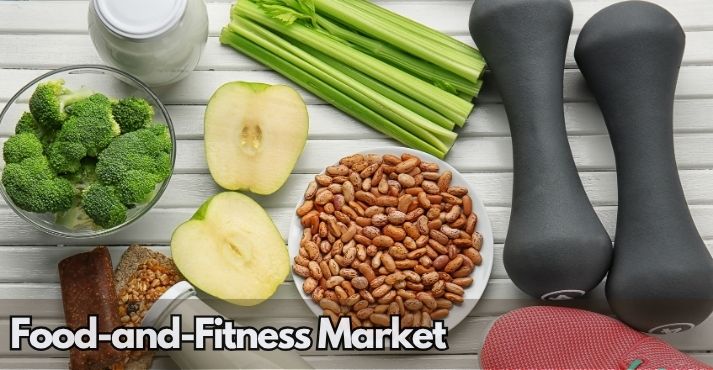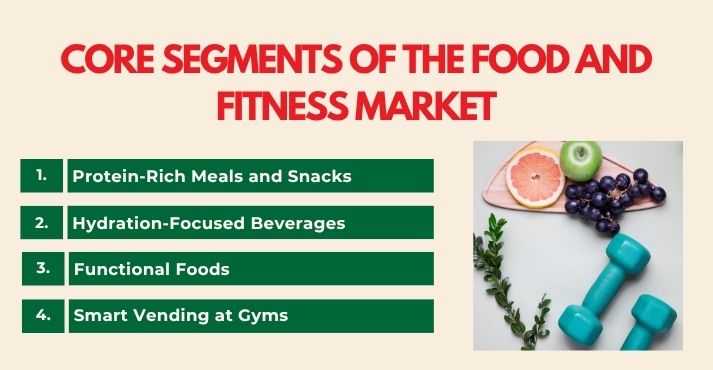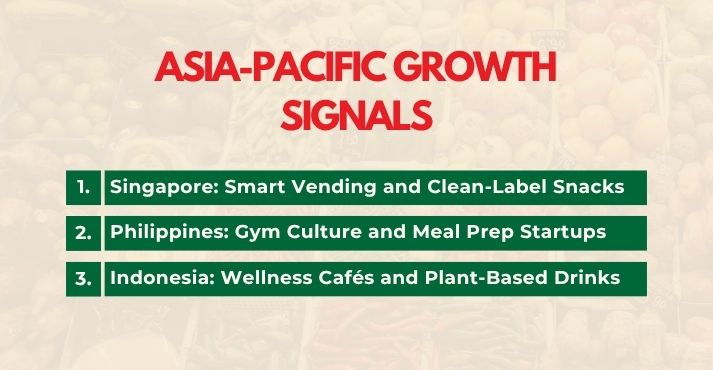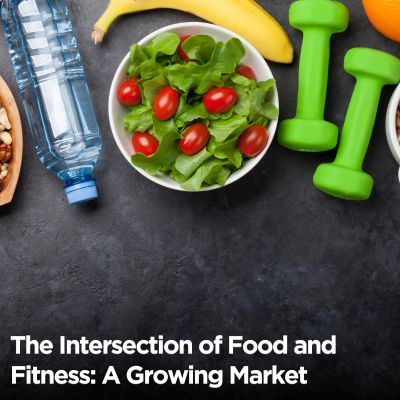People no longer see “eating well” and “working out” as separate habits. Instead, they have become part of a lifestyle where food and fitness work together to help people stay healthy and feel their best.
This change creates various opportunities for businesses in the food and fitness sectors to develop products and services that cater to these combined needs.
The global sports nutrition and supplements market was valued at approximately $28.4 billion in 2023 and is projected to reach over $37.8 billion by 2028. This shows a strong demand for foods and supplements that support physical activity, muscle recovery, and overall wellness.
In Southeast Asia, wellness culture is gaining popularity. Fitness studios are opening in cities, health challenges encourage people to stay active, and plant-forward diets are becoming more common.
Consumers seek convenient and tasty options that help fuel their workouts and sustain their energy throughout the day.
For businesses and investors, the food and fitness market offers a valuable chance to meet these needs with innovative, health-focused products and services.
What is the Food-and-Fitness Market?

The food-and-fitness market includes products and venues that enhance performance, facilitate recovery, and integrate into wellness routines.
This category covers protein-rich meals and snacks, hydration-focused beverages, functional foods containing adaptogens, probiotics, or BCAAs, as well as smart vending solutions commonly found in gyms, yoga studios, and airports.
These options help consumers boost their physical health through nutrition and easy access to fitness-focused choices.
Core Segments

The food and fitness market includes a range of products customized to support various aspects of health and physical activity.
These core segments cater to consumers seeking to enhance performance, accelerate recovery, and maintain overall wellness through targeted nutrition and convenient access.
1. Protein-Rich Meals and Snacks
Protein is essential for muscle repair and overall health. The demand for protein-rich meals and snacks has grown as more consumers recognize the importance of protein in their diets.
These products are commonly featured in fitness-focused dining at gyms, cafes, and restaurants catering to active lifestyles. Popular options include lean meats, legumes, dairy, and plant-based alternatives that help support muscle recovery and growth.
2. Hydration-Focused Beverages
Proper hydration is essential for good performance and recovery. Hydration-focused beverages, including electrolyte-infused drinks and water enhancers, are gaining popularity among fitness enthusiasts.
These beverages help replenish lost fluids and electrolytes during and after exercise, supporting sustained energy levels and preventing dehydration.
3. Functional Foods with Adaptogens, Probiotics, or BCAAs
Functional foods provide health benefits in addition to basic nutrition. Incorporating ingredients like adaptogens, probiotics, or Branched-Chain Amino Acids (BCAAs), these foods aim to support various aspects of health, including stress management, gut health, and muscle recovery.
The global functional food market was valued at approximately $218.41 billion in 2023 and is projected to reach $347.64 billion by 2032, growing at a CAGR of 5.30%.
4. Smart Vending at Gyms, Yoga Studios, Airports
Smart vending solutions are improving the accessibility of health-focused products. These vending machines are equipped with technology that enables cashless transactions, provides personalized recommendations, and tracks real-time inventory.
They provide a convenient way for consumers to access protein bars, hydration options, probiotic drinks, and other wellness products. The integration of such technology enhances the consumer experience and meets the increasing demand for on-the-go health solutions.
The Rise of the Performance-Minded Consumer
In Southeast Asia, more people are choosing foods that match their active lifestyles. These aren’t just athletes, but they also include busy professionals, students, and parents who want meals and snacks that support their health goals.
Millennials and Gen Z, in particular, are scrutinizing food labels, checking for macronutrients, and selecting products that offer genuine health benefits.
According to a report from Ai Palette, about 130 million Southeast Asian consumers are part of the holistic wellness snack segment. Within just two years, this category has grown by 43%.
Another 40 million consumers are opting for premium and protein-focused snacks, with both categories experiencing over 50% growth during the same period.
This interest in healthy food has led to more demand for items that include performance ingredients like BCAAs, probiotics, and plant-based protein.
Wellness-driven menus at cafés and restaurants are now including protein-focused meals alongside cleaner, organic food options.
The sports nutrition industry is offering a range of functional foods and drinks to meet these needs, including probiotic drinks, protein shakes, and nutrient-rich snacks that are easy to grab on the go.
For product developers and F&B operators, this change in buying habits creates a need to offer healthy grab-and-go choices and innovate with ingredients that support active lifestyles.
Whether through fitness cafes or packaged snacks, the food and fitness market is creating new opportunities to cater to consumers who want more from their food.
Brand Innovation at the Food-Fitness Crossroads
Food and fitness now go hand in hand, with brands offering simple, healthy options for people who stay active. These products and services make it easier to eat well and stay energized throughout the day.
Gym-Linked Cafés
- F45 Training pairs its workouts with protein-rich smoothies and snacks available at select studios. These gym-goer meals help support recovery and maintain energy after exercise.
- Anytime Fitness features smoothie corners in various locations, offering members convenient access to nutritious beverages that complement their fitness routines.
Retail Meal Solutions
- My Muscle Chef in Australia delivers high-protein, ready-made meals designed for muscle recovery and overall health. Their offerings cater to individuals seeking functional fitness foods that fit into their busy schedules.
- Feed in Europe offers balanced, plant-based meal replacements that serve as convenient options for individuals seeking to maintain a healthy diet while pursuing their fitness goals.
- Sustyfoods in Singapore offers plant-based meal replacement shakes made from whole foods, providing a nutritious and convenient option for health-conscious consumers.
Restaurants with Health-Focused Menus
- Pokeworks allows customers to customize poke bowls with a variety of bases and proteins, offering calorie information to help diners make informed choices that align with their health tracking efforts.
In the United States, the FDA requires chain restaurants with 20 or more locations to display calorie information on their menus, helping consumers make informed dietary decisions that support their wellness objectives.
These examples show how brands are catering to the needs of individuals who prioritize health and fitness daily.
Asia-Pacific Growth Signals

Health-focused food and beverage choices are becoming more common across the Asia-Pacific region.
Countries such as Singapore, the Philippines, and Indonesia are experiencing a surge in demand for performance nutrition, plant-based beverages, and convenient formats like smart vending machines.
Singapore: Smart Vending and Clean-Label Snacks
Singapore has become a hub for fitness-focused innovation in the food and beverage sector. Clean-label snacks and functional drinks are now commonly found in gyms, wellness cafes, and convenience stores.
Smart vending F&B solutions are also appearing in train stations and office buildings, offering quick access to nutrient-rich options for busy consumers.
The government’s front-of-pack labeling policies and public health campaigns have encouraged both brands and consumers to prioritize better ingredients, such as plant-based proteins and low-sugar beverages.
The demand for probiotic drinks and organic food continues to influence new product lines customized to active lifestyles.
Philippines: Gym Culture and Meal Prep Startups
Sports nutrition sales in the Philippines are expected to rise, with more consumers using online platforms to access supplements, ready-made gym-goer meals, and health-focused snacks.
Alongside a strong fitness culture, small businesses offering performance-based meal prep services are attracting customers who want protein-focused meals that match their workout plans.
Indonesia: Wellness Cafés and Plant-Based Drinks
The demand for plant-based food and drinks in Indonesia is on the rise. According to a Float Foods survey, 78% of Indonesians have tried vegan meat alternatives, and nearly a quarter expressed interest in eating more plant-based meals.
This has led to more wellness cafés offering functional fitness foods, including plant-based protein drinks and organic food options that support active lifestyles and daily nutrient needs.
What’s Driving This Growth?
Several factors are helping expand the food and fitness market across Southeast Asia. Consumers are paying more attention to daily habits that support both physical health and mental well-being.
As active living becomes a significant part of everyday life, food choices are being influenced more by fitness routines, energy needs, and recovery goals.
Cities throughout the region are witnessing an increase in the number of fitness studios and boutique gyms opening in residential neighborhoods, office buildings, and malls.
The rise in gym memberships has created demand for nearby options that serve people before and after workouts, whether it’s a smoothie, a quick protein snack, or recovery food. Many gym-goers now expect on-site or adjacent cafés that offer meals to support their training.
Flexible work setups, such as hybrid models, have allowed people to incorporate workouts into their daily routines easily. This flexibility has also changed eating habits.
Instead of three fixed meals, there’s more interest in smaller, nutrient-rich meals spread throughout the day. This has led to a greater demand for portable foods like pre-packed bowls, protein shakes, and healthy snacks that fit active lifestyles.
Social media and fitness wearables continue to influence how people choose what to eat. Many consumers follow trainers or wellness influencers who share daily food routines, ingredient recommendations, and supplement tips.
Wearable devices provide real-time data on calories burned, hydration levels, and recovery status, encouraging users to select meals and snacks that align with their fitness goals.
Recovery food, hydration beverages, and performance snacks are often part of these daily intakes.
Governments in countries like Singapore, Thailand, and Malaysia are supporting healthier living through initiatives such as sugar reduction guidelines, clear nutrition labeling, and school wellness programs.
These efforts have encouraged food brands and cafés to reformulate recipes and add menu items that align with public health goals. National wellness campaigns and government partnerships also offer platforms for promoting food options that suit fitness-focused lifestyles.
Challenges to Navigate
Building food products for active lifestyles comes with practical challenges. Product development takes time and budget, especially when working with ingredients that support energy, recovery, or muscle health.
It’s not easy to make protein-packed meals or drinks that also taste good and last on the shelf. Brands often have to adjust recipes multiple times to get the right texture, flavor, and function.
Trust is another issue. Many consumers now expect short ingredient lists and the absence of additives, but not all understand what truly makes a product healthy.
Some items use fitness-friendly labels or buzzwords without offering real nutritional value. This has made people more cautious and harder to convince. Clean-label trust has to be earned.
There are also legal requirements to manage. Countries in Southeast Asia have different rules for making claims like “rich in protein” or “supports recovery.”
Businesses must back these claims with data and often need approval to use them on packaging. This slows things down, especially for brands that are trying to expand across multiple markets.
Finding ingredients is another hurdle. Many shelf-stable, high-protein sources, especially those derived from plants, can be expensive or difficult to source. Brands have to weigh quality against cost while keeping prices reasonable.
Finally, consumers need better tools to understand the difference between real performance nutrition and food that merely claims to be healthy.
Without clear information, it’s easy to confuse one for the other. Honest labeling, smart education, and strong product design can help close that gap.
Conclusion
The connection between food and fitness is opening new doors for F&B brands across Southeast Asia. As more people seek meals that fit into active, health-focused routines, the demand for practical, nutrient-rich options continues to rise.
This isn’t just about athletes. Every day, consumers seek products that support their energy levels, promote recovery, and enhance their overall well-being. From smart vending F&B to clean-label meal prep trends, there’s clear space for innovation that meets real needs.
Success will come to brands that remain honest about their ingredients, build trust, and make good nutrition more accessible.
As the wellness economy continues to expand, the companies that stay close to consumer needs will help set the standard for what food looks like in everyday life.













